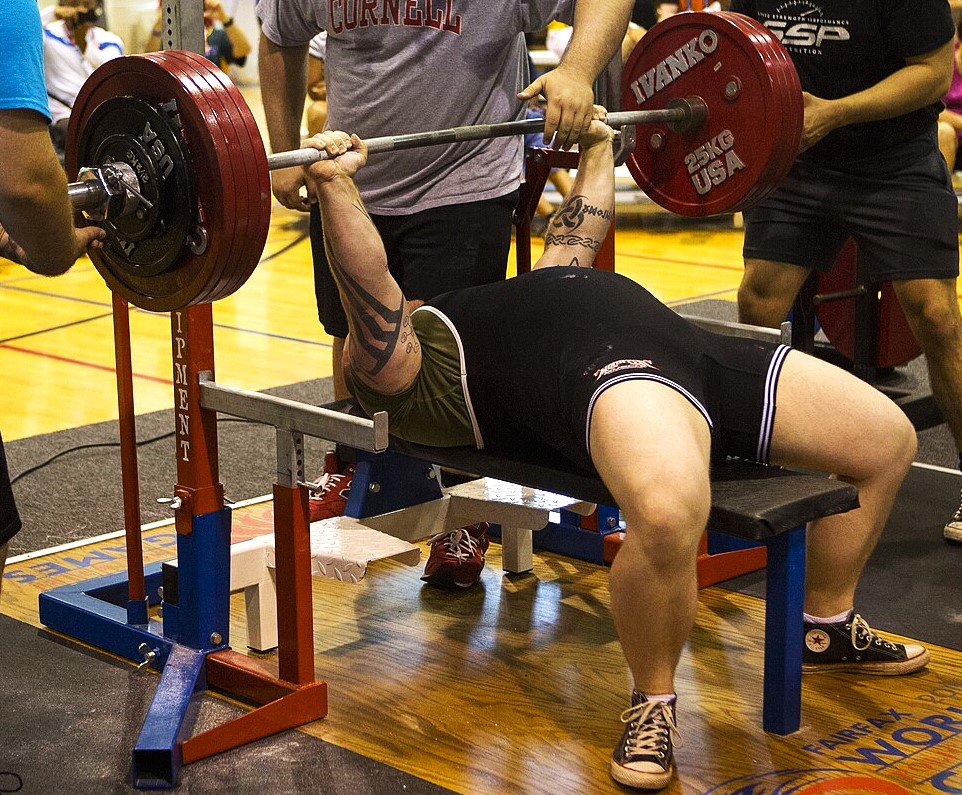James Tourtellotte
How much can you bench? The question is a cliché asked of anyone more diesel than Timothée Chalamet. It matters to most of us. For many, bench press strength is the arbiter of workout success. And so, from the crucial setup until the bar is reracked, we break down exactly how to bench press the most weight, safely and efficiently. Let’s boost your bench.
1. GET A SPOT.
Whenever you plan to push a set of bench presses to near-failure, have a capable spotter hovering just behind you for safety, but also for the peace of mind that will allow you to go for that crucial extra rep that you never locked out before. A study demonstrated that when spotted during bench presses, subjects were 11.2% stronger. That’s the difference between getting nine reps and a PR of 10, or benching 225 versus benching 250. A spotter can also help you unrack and rerack the bar, adding a layer of safety and preserving your all-out strength for the lift itself.
2. TAKE A STANCE.
Lie down on a flat bench. Place your feet flat on the floor, at least shoulder-width apart, and with your heels slightly behind your knees. You want to form a strong base, and to do this you need your feet in the best position to stabilize your body. If your feet are in front of your knees, your base will be weaker. If they’re too far back, your heels will come off the floor, again weakening your base. And, if your feet are on the bench or up in the air, your legs will be useless. We all see people do this. Perhaps you’re guilty of it. Some bodybuilders claim they want to “take their legs out of the lift,” feeling this will help them better focus on their chests. Forget it. All this does is weaken your bench press. It’s like squatting on a wobble board. Doing so will increase your balance but decrease your strength. To grow stronger (and bigger) you want to maximize your bench press, so keep your feet flat on the floor.
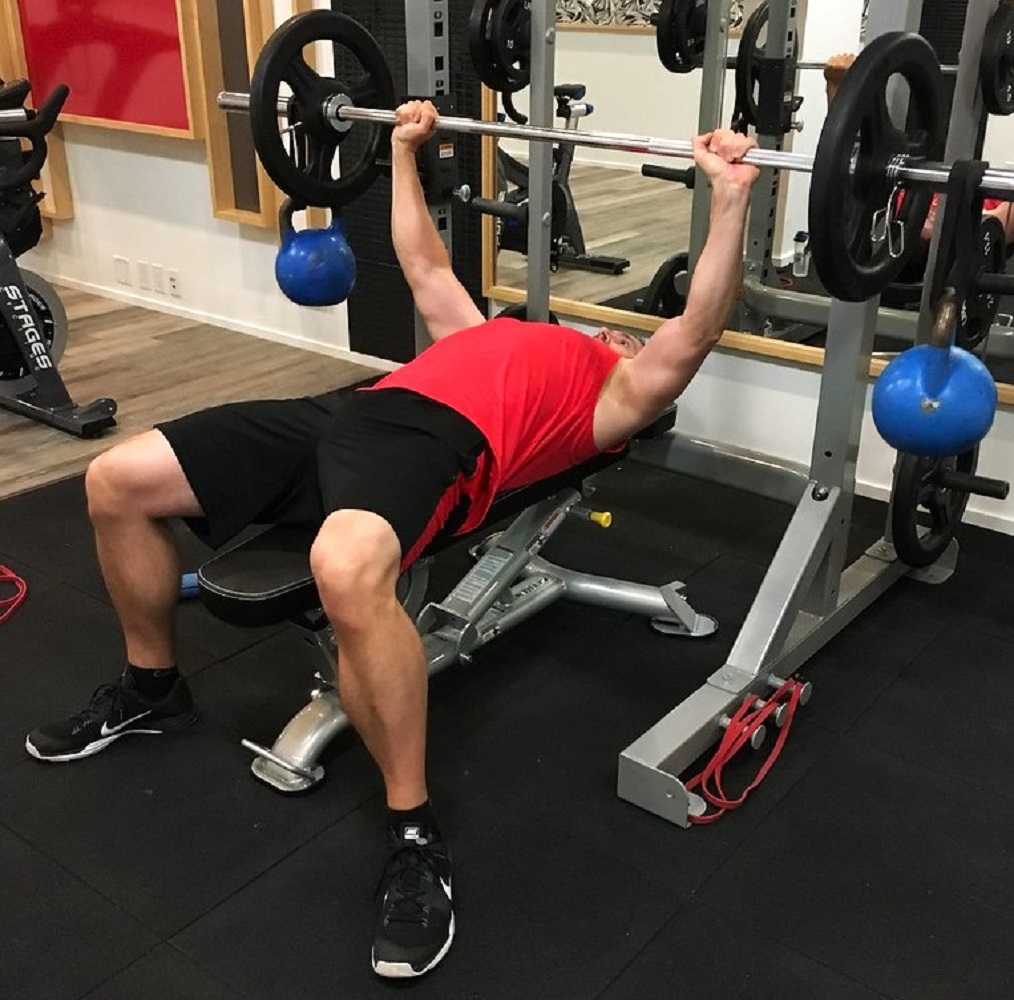
3. GET A GRIP.
The width of your grip will depend on the width of your shoulders. Take a grip with which your forearms are vertical to the floor. A wider grip will reduce the range of motion but may put too much pressure on your shoulders, and a narrower grip will work your triceps more than your chest. We do not recommend a thumbless grip. Grip the barbell low in your palms. This may feel like a less secure grip, but if you take a mid-palm or high-palm grip, your wrists will bend back, limiting your strength and eventually straining wrist tendons. Squeeze the bar and keep your wrists straight. You can use wrist wraps, but they should only be an adjunct to proper technique.
4. ARCH YOUR BACK.
Your spine has a natural curve. You want to maintain this or slightly exaggerate it during each rep of bench presses. This puts you in the strongest position, and also raises your chest, slightly reducing the range of motion. An extremely exaggerated arch can dramatically reduce the range of motion, but it can also compress your spine. Arch naturally and keep your butt tensed and touching the bench but not supporting any of your body weight. Lower body support will come from your legs, not your glutes. You may wish to wear a weightlifting belt to keep your core tight and supported.
5. TENSE YOUR UPPER BACK.
Before you unrack the weight, squeeze your shoulder blades back to tense your upper, inner back (trapezius). Staying tensed throughout the set boosts stability and strength. You’re not just lying on the bench. You’re pressing against it with your upper back. Keep your shoulders down. Many people reflexively raise their shoulders, as if to meet the bar, but this lengthens the range of motion. If you keep your shoulders down and upper back flexed, your chest will be maximally elevated, shortening the range of motion.
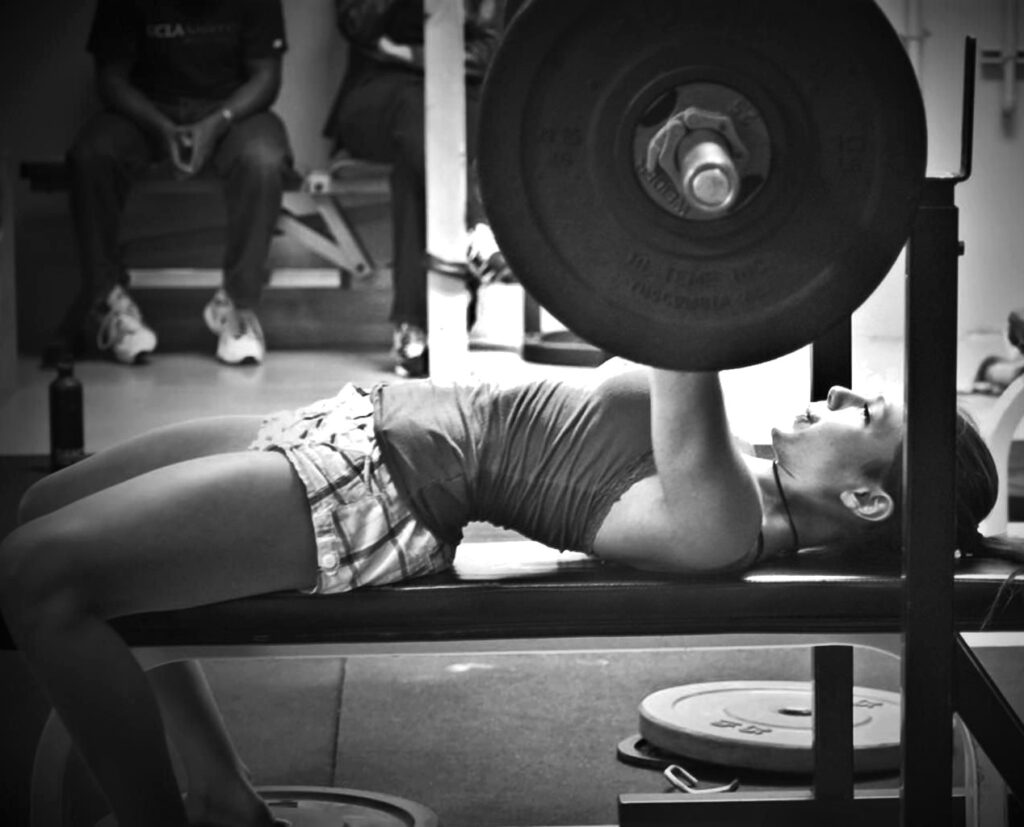
6. UNRACK THE BAR.
Position yourself so you need to move the bar forward no more than a couple of inches, just enough so your reps clear the supports. Having to reach back to unrack the bar by yourself and then pull it forward drains energy and strength before you’ve even begun your set. Take the barbell off the supports, ideally with the assistance of a spotter, by slightly straightening your previously slightly bent arms. Throughout the liftoff, keep your shoulders back (don’t bring them up to unrack the weight), chest up, back tensed, spine naturally arched, butt brushing the bench, glutes and legs tensed, and feet firmly on the floor.
7. HOLD YOUR BREATH.
Inhale through your nose deeply at the beginning of each rep. Hold that breath as you lower the bar and raise the bar. Exhale through your nose just as you’re beyond any sticking point and locking out each rep, and then inhale for the next rep (assuming there’s a next rep). This contradicts advice that is often given to hold your breath on the way down and let it go on the way up. But, of course, the way up is the hard part. So, letting your breath out then relieves tension, and you want to keep your torso tense to maximize power. Hold your breath until you’re certain you’re about to lock out the rep.
8. LOWER THE BAR.
This is the most important part of the lift because it’ll setup how you press the bar. If your form isn’t right when the bar’s coming down, it’s going to be wrong as the bar goes up (or doesn’t go up). The first thing to know is the barbell shouldn’t travel straight down, because it shouldn’t travel straight up. Take the bar down at a slight diagonal angle from your shoulders to your lower chest. (This will be more pronounced after your first rep.)
The second thing you need to focus on is elbow flare versus elbow tuck. Traditionally, bodybuilders bench pressed with their arms at 90-degree angles to their torsos. Necessarily, because of this flare, they also lowered the bar to their mid-to-upper chests. Watch videos or look at photos of Arnold Schwarzenegger or Franco Columbu benching, and you’ll see their arms flared out perpendicular to their sides, and together that duo possessed four of the best pecs of all time.
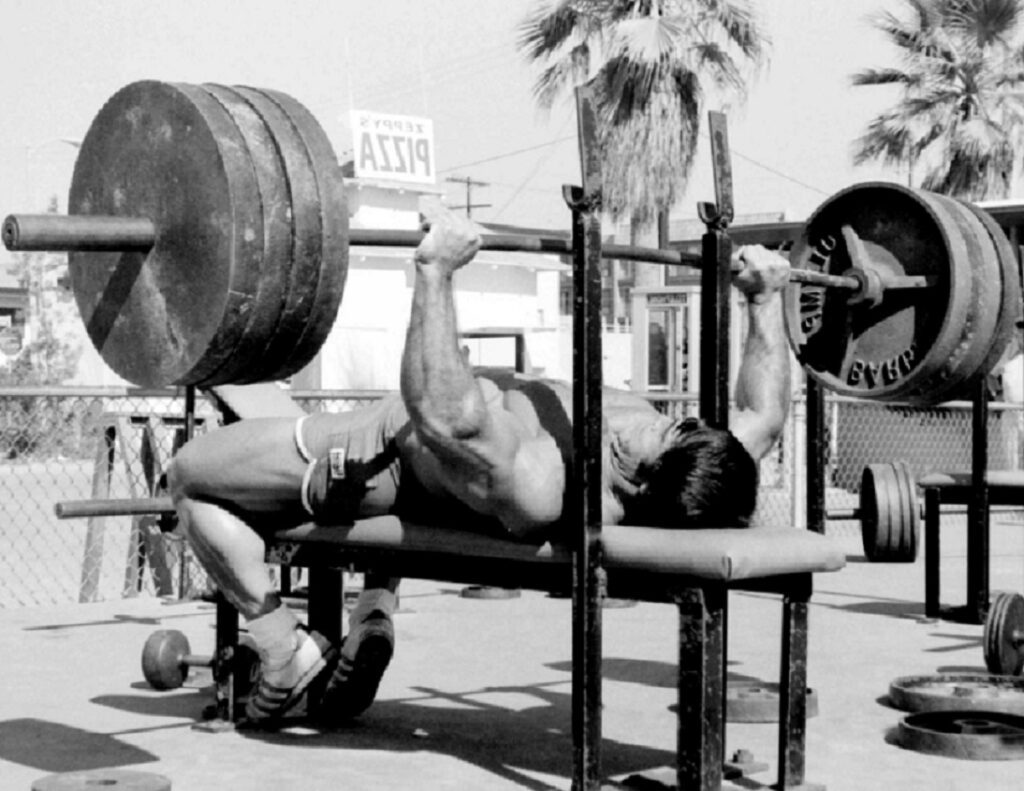
Conversely, powerlifters usually tuck their elbows in, aiming for 45-degree angles, though some keep their elbows even closer to their sides—especially if they’re wearing a bench shirt which severely limits mobility. The Arnold and Franco way targets the pectorals by stretching them more, but it also puts shoulder joints in jeopardy. The powerlifting way places you in a safer and stronger position, but works the chest less. If strength is your primary goal, go with 45-degrees. If your first goal is pectoral hypertrophy but you also want a bigger bench, compromise and go with something between 45 and 90, but closer to the former. Keep your arms at approximately 75-degree angles to your torso as you lower the bar. It will take practice to discover what are the best arm angles for you, but we recommend sticking to the 45-75-degree range. Even if it feels uncomfortable at first, it should prove to be strongest.
Keep your muscles tight from your hands to your upper back to your glutes to your legs. If anything, you want to get even tighter as the barbell descends, building tension for the ascent. Lower the bar under control, but not slowly. Imagine you’re doing an upside-down barbell row. You don’t want to waste any strength on the descent, but you also don’t want the bar to fall out of its groove or descend so fast that it bounces against your chest.
9. BOTTOM OUT.
Touch the barbell to your lower pecs. Don’t pause. Powerlifters have to do so by rule. But there’s no good reason for you to make you bench presses harder. Touch and go, but never bounce.
10. PRESS THE BAR.
Keep your glutes touching the bench, and drive your feet down, as if to push them through the floor. Simultaneously, press the bar away from you by driving your upper back into the bench. Keep your chest up, shoulders down. Instead of focusing on the weight’s movement, imagine that you’re pushing yourself away from the barbell, as if doing an upside-down push-up. This will help you stay tight and form the strongest base of strength to propel the barbell up. Your upper arms are going to stay at the same angle they were during the descent: 45-75 degrees. Your forearms should be nearly vertical but angled backwards very slightly, and your wrists need to stay straight; don’t let your hands bend back. These are all links in the chain, and each needs to stay in the strongest possible position.
The reason the bar traveled down at a slight diagonal angle is because it’s now going to go up at that angle, reversed: from your lower chest to your shoulders. Of course, the shortest path is always a straight line, so it’s rational to assume straight up and down would be the most efficient bench press route. However, another law of physics alters that first law. This one, involving something called the moment arm, says you want to keep the resistance close to the axis of rotation, which in this case is your shoulder joints. You also want to get the bar over all the involved joints and muscles at the difficult lockout portion of the ascent. So, even though the bench press movement is a little longer, bringing the bar slightly backwards from the lower chest to the shoulder joints as you lift puts you in the strongest biomechanical position to complete reps.
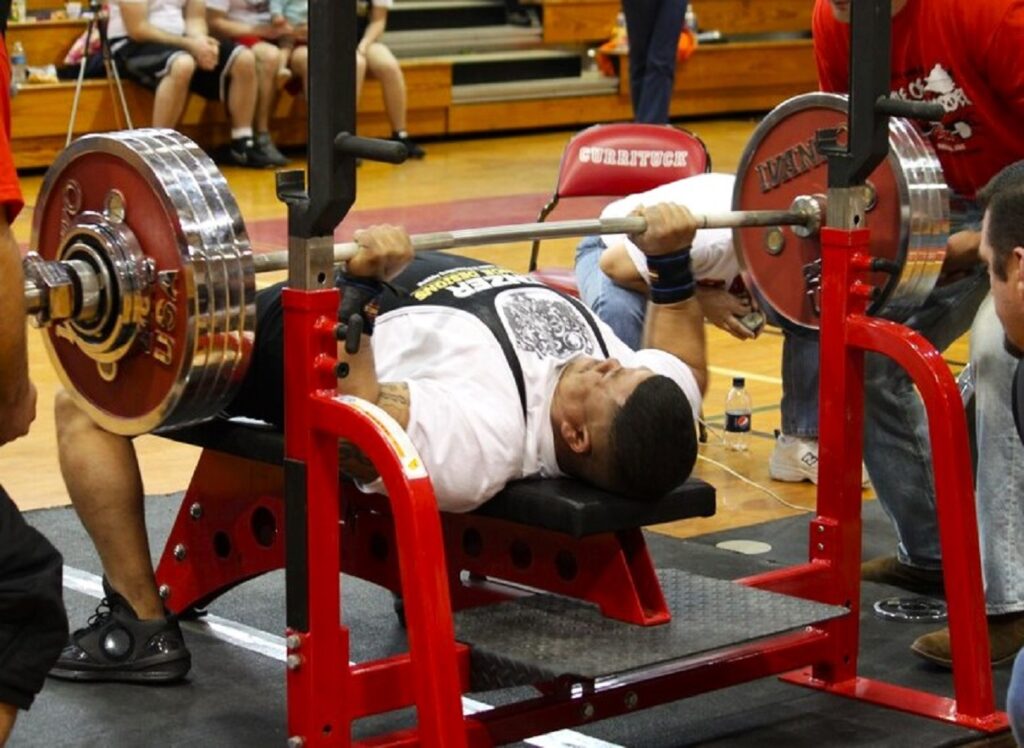
11. LOCKOUT.
The barbell should end its down and up journey above your shoulders, where it began. Lockout your elbows briefly at the top while maintaining the tension in your body and arch in your spine. (If you have trouble with lockouts, do sets focused on just the final halves of reps in a power rack or on a Smith machine.) Don’t pause. As with the touch and go at the bottom, lock briefly and go on to your next rep.
12. RERACK THE WEIGHT.
On the final rep, rack the weight by yourself or have a spotter help. And then rest up at least three minutes before your next set of bench presses.
HOW TO BENCH PRESS: FAQS
Should the bar touch your chest when benching?
Yes. Let the barbell touch your chest but don’t bounce it.
Where should the bar touch your chest on a bench press?
Your lower chest.
What is a reasonable weight to bench press?
A novice woman aged 20-40 should be able to bench press about 60% of her body weight for a single rep, and an advanced female trainer about 90%. A novice man aged 20-40 should be able to bench press about 90% of his body weight for a single rep, and an advanced male trainer at least 150%.
Is 135 a good first bench?
It is for a young person, woman, or a man who weighs 150 or less.
Is 225 a good bench press?
What’s good depends on several factors, especially your weight, gender, age, and level of training experience.
What is the secret to bench press?
There is no secret. But the best advice is to think of the bench press as a full-body exercise and not just a chest builder. So stay tense from your feet to your hands.
Should a beginner bench press?
Bench presses are a good, basic exercise for beginning weight-trainers.
Can I bench press by myself?
Yes. But take precautions. You can bench press in a power rack with the supports set at chest level or slightly above, so you can get out safely if you miss the last rep. But without safety supports, don’t push your final rep to failure. And don’t use collars to lock the weights on, because if you fail without collars and the barbell is stuck on your chest, you can tip the bar to one side and then the other to ditch the weights.



































